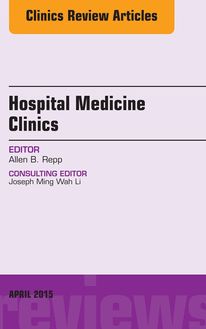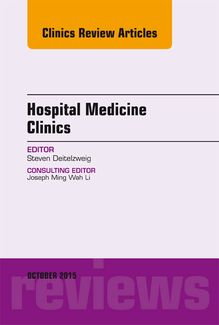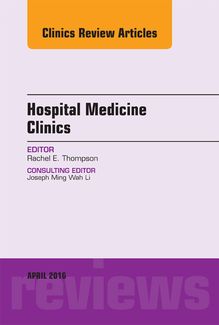Volume 4, Issue 3, An Issue of Hospital Medicine Clinics, E-Book , livre ebook
146
pages
English
Ebooks
2015
Vous pourrez modifier la taille du texte de cet ouvrage
Obtenez un accès à la bibliothèque pour le consulter en ligne En savoir plus
Découvre YouScribe en t'inscrivant gratuitement
Découvre YouScribe en t'inscrivant gratuitement
146
pages
English
Ebooks
2015
Vous pourrez modifier la taille du texte de cet ouvrage
Obtenez un accès à la bibliothèque pour le consulter en ligne En savoir plus
Publié par
Date de parution
27 octobre 2015
Nombre de lectures
1
EAN13
9780323396820
Langue
English
Poids de l'ouvrage
1 Mo
Publié par
Date de parution
27 octobre 2015
Nombre de lectures
1
EAN13
9780323396820
Langue
English
Poids de l'ouvrage
1 Mo
Clinics Review Articles
Hospital Medicine Clinics
Mark Thoelke, MD, SFHM
Washington University School of Medicine, St Louis, MO, USA
ISSN 2211-5943 Volume 4 • Number 3 • July 2015
Elsevier
Table of Contents
Cover image
Title page
Contributors
Consulting Editor
Editor
Authors
Forthcoming Issues
Forthcoming Issues
Recent Issues
Preface
Heart Failure with Preserved Ejection Fraction
Definitions
Epidemiology
Pathophysiology and cause
Patient evaluation and diagnosis
Treatment and prognosis
Uncontrolled hypertension
Atrial fibrillation
Tachycardia
Cardiac ischemia
Hemodynamic deterioration
β-Blockers
Angiotensin-converting enzyme inhibitors
Angiotensin II receptor blockers
Other pharmacologic therapies
Performance improvement
Clinical guidelines
Wheezing
Definition
Causes
Epidemiology
Evaluation and diagnosis
Management: asthma
Management: chronic obstructive pulmonary disease
Management: acute bronchospasm
Performance improvement
Clinical guidelines
Fungal Infections in the Hospitalized Patient
Fungemia
Funguria/candiduria
Endemic fungi: histoplasmosis, blastomycosis, coccidiomycosis
Obstructive Uropathy
Epidemiology
History, examination, and laboratory findings
Imaging
Therapy
Prognosis
Performance improvement
Acute Cholecystitis, Choledocholithiasis, and Acute Cholangitis
Definitions
Epidemiology
Patient history
Physical examination
Imaging and additional testing
Medical treatment options
Surgical treatment options
Clinical guidelines
Performance improvement
Posterior Reversible Encephalopathy Syndrome
Hypertension
Preeclampsia/eclampsia
Organ/tissue transplantation
Drugs
Renal disease
Infection/sepsis/shock
Summary
Paraneoplastic Syndromes
Definition
Prevalence
How are paraneoplastic syndromes classified?
Endocrine paraneoplastic syndromes
Hematologic paraneoplastic syndromes
Renal paraneoplastic syndromes
Dermatologic paraneoplastic syndromes
Neurologic paraneoplastic syndromes
Rheumatologic paraneoplastic diseases
Discharges Against Medical Advice
Clinical guidelines
Medicolegal case examples in which the designation “against medical advice” was either not protective or only partially protective
Myth buster
Performance improvement
Prescribing Methadone
Definitions
Indications for methadone use
Government regulations
Prescribing
Safety
Monitoring
Special populations
Caring for the Actively Dying
Clinical guidelines
Performance improvement
Contributors
Consulting Editor
JOSEPH MING WAH LI, MD, SFHM, FACP
Chief, Section of Hospital Medicine, Division of General Medicine and Primary Care, Beth Israel Deaconess Medical Center; Associate Professor of Medicine, Harvard Medical School, Boston, Massachusetts
Editor
MARK THOELKE, MD, SFHM
Chief of Hospital Medicine; Associate Professor of Medicine, Washington University School of Medicine, St. Louis, Missouri
Authors
ANNA M. ARROYO-PLASENCIA, MD, FHM
Assistant Professor of Medicine, Division of Hospital Medicine, Department of Medicine, Washington University School of Medicine, St. Louis, Missouri
RACHEL H. BARDOWELL, MD
Instructor of Medicine, Division of Hospital Medicine, Washington University School of Medicine, St. Louis, Missouri
MARIA DANS, MD
Director, Barnes-Jewish Hospital Palliative Care Service; Assistant Professor of Medicine, Division of Hospital Medicine, Washington University School of Medicine, St. Louis, Missouri
JAMES FREER, MD
Assistant Professor of Medicine, Division of Hospital Medicine, Washington University School of Medicine, St. Louis, Missouri
MARGO GIRARDI, MD
Instructor of Medicine, Division of Hospital Medicine, Department of Internal Medicine, Washington University School of Medicine, St. Louis, Missouri
AARON P. HARTMANN, PharmD, BCPS
Internal Medicine Clinical Pharmacist, Barnes-Jewish Hospital; Assistant Professor, St. Louis College of Pharmacy, St. Louis, Missouri
ERIC K. JOHNSON, MD
Division of Hospital Medicine, Washington University School of Medicine, St. Louis, Missouri
CAROLINE HOLLECK KAHLE, MD
Assistant Professor of Medicine, Division of Hospital Medicine, Washington University School of Medicine, St. Louis, Missouri
MARTIN KERRIGAN, MD
Assistant Professor of Medicine, Division of Hospital Medicine, Washington University School of Medicine, St. Louis, Missouri
EILEEN LEE, MD
Instructor of Medicine, Division of Hospital Medicine, Washington University School of Medicine, St. Louis, Missouri
MICHAEL Y. LIN, MD
Division of Hospital Medicine, Washington University School of Medicine, St. Louis, Missouri
ADAM LITTICH, MD
Instructor of Medicine, Division of Hospital Medicine, Department of Internal Medicine, Washington University School of Medicine, St. Louis, Missouri
ROBERT J. MAHONEY, MD
Assistant Professor of Medicine, Division of Hospital Medicine, Washington University School of Medicine, St. Louis, Missouri
NATHAN MARTIN, MD
Assistant Professor of Medicine, Division of Hospital Medicine, Department of Internal Medicine, Washington University School of Medicine, St. Louis, Missouri
CHERYL R. McDONOUGH, MD
Instructor of Medicine, Division of Hospital Medicine, Department of Internal Medicine, Washington University School of Medicine, St. Louis, Missouri
ADAM MEYER, MD
Instructor of Medicine, Division of Hospital Medicine, Washington University School of Medicine, St. Louis, Missouri
DEVIN C. ODOM, MD
Instructor of Medicine, Department of Medicine, Washington University School of Medicine, St. Louis, Missouri
HILARY E.L. RENO, MD, PhD
Assistant Professor, Department of Medicine, Washington University School of Medicine, St. Louis, Missouri
MYRA L. RUBIO, MD
Assistant Professor of Medicine, Division of Hospital Medicine, Washington University School of Medicine, St. Louis, Missouri
RICHARD A. SANTOS, MD, PhD
Assistant Professor of Medicine, Division of Hospital Medicine, Washington University School of Medicine, St. Louis, Missouri
AMY SHELDAHL, MD
Assistant Professor of Medicine, Division of Hospital Medicine, Washington University School of Medicine, St. Louis, Missouri
MARK THOELKE, MD, SFHM
Chief of Hospital Medicine; Associate Professor of Medicine, Washington University School of Medicine, St. Louis, Missouri
Contents
Preface A7
Mark Thoelke
Heart Failure with Preserved Ejection Fraction 283
Adam Meyer and Martin Kerrigan
Heart failure with preserved ejection fraction (HFpEF) affects approximately half of all patients with heart failure and is a common reason for admission to the hospital. The most common factors associated with developing HFpEF include age, female sex, uncontrolled hypertension, and obesity. Management of HFpEF consists of symptomatic control with diuretics and controlling comorbidities such as hypertension and atrial arrhythmias. Choice of antihypertensive is guided by underlying comorbidities; studies have shown no mortality benefit with angiotensin-converting enzyme (ACE) inhibitors or angiotensin receptor blockers (ARBs). However, ACE inhibitors and ARBs showed some reduction in hospital readmissions for patients with HFpEF.
Wheezing: Asthma, Chronic Obstructive Pulmonary Disease, and More 297
Rachel H. Bardowell and Robert J. Mahoney
Wheezing can be caused by a variety of conditions. In hospitalized adults, primary considerations include asthma, chronic obstructive pulmonary disease (COPD), and acute bronchospasm related to an allergic reaction. The treatment of acute exacerbations of asthma and COPD is similar; some key differences are discussed. Patients with COPD are at high risk of readmission, and hospitals see a reduction in reimbursement for excessive readmissions. Strategies for reducing readmissions in patients with asthma and COPD include promoting medication adherence, smoking cessation, action plan/self-management development, and vaccination.
Fungal Infections in the Hospitalized Patient 313
Devin C. Odom and Hilary E.L. Reno
Fungal infections are becoming common inpatient diagnoses that require high clinical suspicion and specialized treatment of immune-compromised and immune-competent patients alike. This article provides a brief review of the epidemiology, species, and treatment of fungemia and funguria. Common endemic North American fungal diseases (histoplasmosis, blastomycosis, coccidiomycosis, and cryptococcosis) are also discussed in detail, with a focus on management.
Obstructive Uropathy 328
Margo Girardi and Nathan Martin
Obstructive uropathy is blockage of urinary flow anywhere along the urinary tract. Obstructive uropathy can be asymptomatic or present as pain, nausea, vomiting, hematuria, or change in urinary flow. When obstructive uropathy is considered, a full physical examination is needed. Laboratory tests include a basic metabolic panel, complete blood count, and urinalysis. Ultrasonography, computed tomography, and MRI are the most common imaging tests used to diagnose obstructive uropathy. Ultrasonography is the most cost-effective and safe for patients and therefore a good initial modality. Medical treatment depends on cause. Surgical treatment of obstructive uropathy includes ureteral stents and percutaneous nephrostomy tubes.
Acute Cholecystitis, Choledocholithiasis, and Acute Cholangitis 342
Adam Littich and Cheryl R. McDonough
This article defines the clinical entities of acute cholecystitis, choledocholithiasis, and cholangitis and provides an overview of the clinical presentation, laboratory and physical examination findings, imaging standards, and treatment guidelines for each.
Posterior Reversible Encephalopathy Syndrome 358
Eric K. Johnson and Michael Y. Lin
Posterior reversible encephalopathy syndrome (PRES) is characterized by headache, altered consciousness, visual disturbances, and seizures,




